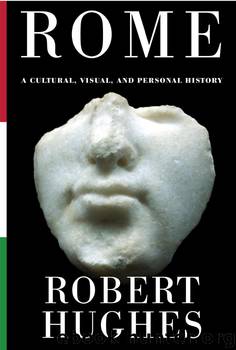Rome by Robert Hughes

Author:Robert Hughes [Hughes, Robert]
Language: eng
Format: epub, mobi
ISBN: 978-0-307-70058-2
Publisher: Knopf Doubleday Publishing Group
Published: 2011-10-31T16:00:00+00:00
Among all those who have held the place
Of God’s vicar, there had never been seen before
Such a quarrelsome, tough, crazy
Pope as Pope Sixtus.
Nor would there ever be again. A visitor from Mantua, Angelo Grillo, reported, “Such is the newness of the edifices, the streets, piazzas, fountains, aqueducts, obelisks, and other stupendous marvels which Sixtus V of glorious memory embellished this old city” that he could hardly recognize the place he had left ten years before. Later popes would build, but not with such a commitment to reorganize the basic pattern, the manifest sense of space, that was Rome. In a sense, the “building popes” of the Baroque era stood in the shadow of Sixtus’ obsession with the city as a pattern of movement and coordinated public declamation, not just a collection of separate monuments. So the visitor to Rome feels gratitude to this man, so inventive, so tyrannous, and so dreadful in different ways. Yet few could be surprised to learn that a statue of him, erected in his honor on the Capitol when he was alive, was torn down by the common people of Rome—the “rabble”—as soon as the breath was out of his body. They must have felt a right to smash it, since it had been put up with the tax money Sixtus extorted from them.
And what of his early seventeenth-century successors? How did they change the appearance and layout of Rome? Very considerably, though perhaps not as radically as terrible Sixtus.
The greatest scheme was the one accomplished during the pontificate of Alexander VII Chigi (reigned 1665–67)—the rebuilding of Piazza del Popolo, which lay just inside the Porta del Popolo, one of the chief entrances to Rome. “Popolo” does not carry some proto-socialist implication; in the Middle Ages, populus was a politically neutral term, meaning simply “parish.”
Alexander VII cleared the way for his urban desires by reviving the Congregazione delle Strade, the planning commission for Rome, which had fallen into disuse. He gave it the authority to demolish whatever it wished, whenever it saw fit. This was a powerful license. It enabled him, for instance, to get rid of the Arco di Portogallo, which, by constricting the Via del Corso, caused endless traffic jams.
What Alexander favored was generous squares approached by wide streets (no more medieval crimps and doglegs) marked out by distinctive buildings, fountains, and groups of statuary: these he called teatri, “theaters,” and certainly Piazza del Popolo showed what he meant. It was the first part of Rome that most arriving foreigners saw, and it deserved special treatment. Gian Lorenzo Bernini had designed the gate with the Chigi star carried proudly above it, and at the other end of the piazza now rose twin churches. Designed by the architect Carlo Rainaldi in 1661–62 and finished by Bernini and Carlo Fontana in 1679–81, these frame the entrances to the trident of streets (Via del Corso, Via del Babuino, Via di Ripetta) that plunge away into the core of Rome, and heighten the sense of anticipation that has already been raised by the Porta del Popolo.
Download
This site does not store any files on its server. We only index and link to content provided by other sites. Please contact the content providers to delete copyright contents if any and email us, we'll remove relevant links or contents immediately.
| Africa | Americas |
| Arctic & Antarctica | Asia |
| Australia & Oceania | Europe |
| Middle East | Russia |
| United States | World |
| Ancient Civilizations | Military |
| Historical Study & Educational Resources |
Room 212 by Kate Stewart(5041)
The Crown by Robert Lacey(4731)
Endurance: Shackleton's Incredible Voyage by Alfred Lansing(4683)
The Iron Duke by The Iron Duke(4293)
The Rape of Nanking by Iris Chang(4139)
Joan of Arc by Mary Gordon(4017)
Killing England by Bill O'Reilly(3953)
Say Nothing by Patrick Radden Keefe(3904)
I'll Give You the Sun by Jandy Nelson(3362)
Shadow of Night by Deborah Harkness(3308)
Hitler's Monsters by Eric Kurlander(3269)
Mary, Queen of Scots, and the Murder of Lord Darnley by Alison Weir(3152)
Blood and Sand by Alex Von Tunzelmann(3140)
Darkest Hour by Anthony McCarten(3072)
Eleanor & Park by Rainbow Rowell(3063)
Margaret Thatcher: The Autobiography by Thatcher Margaret(3029)
Red Famine: Stalin's War on Ukraine by Anne Applebaum(2874)
Book of Life by Deborah Harkness(2869)
The One Memory of Flora Banks by Emily Barr(2803)
